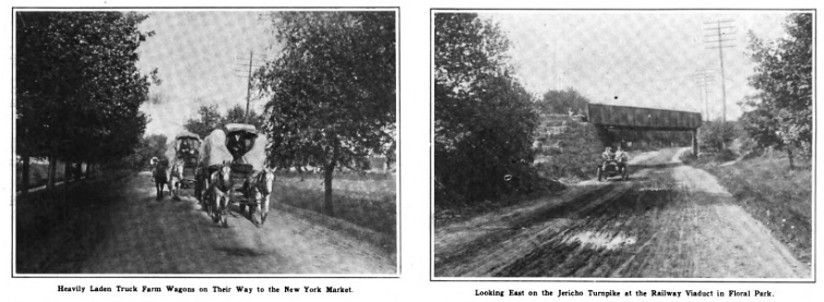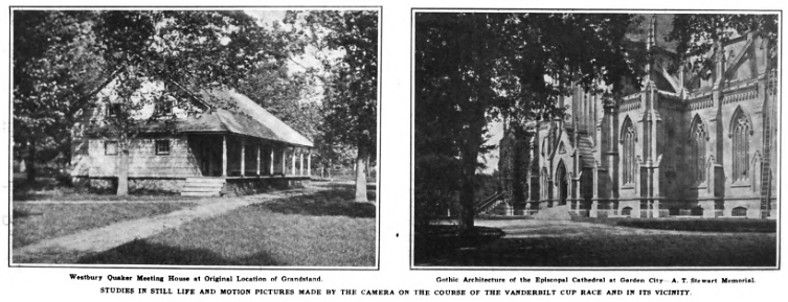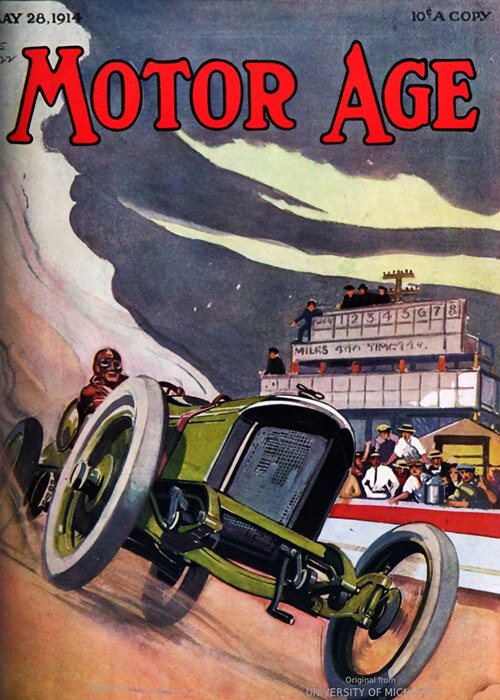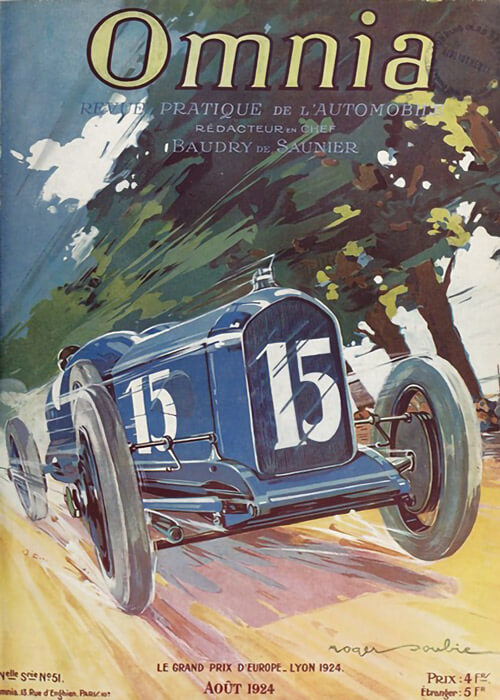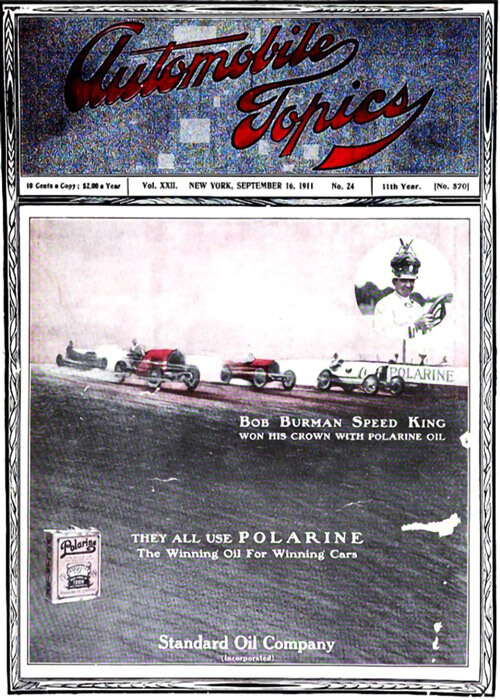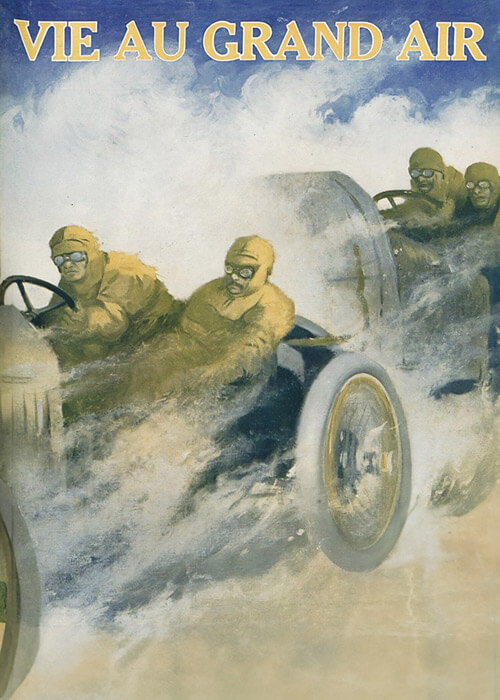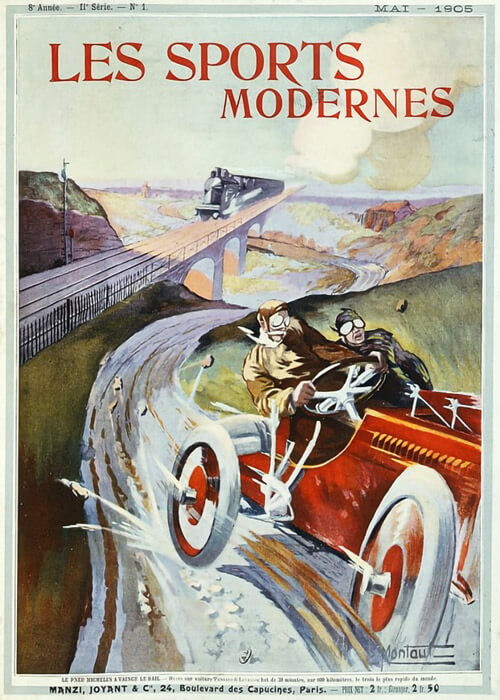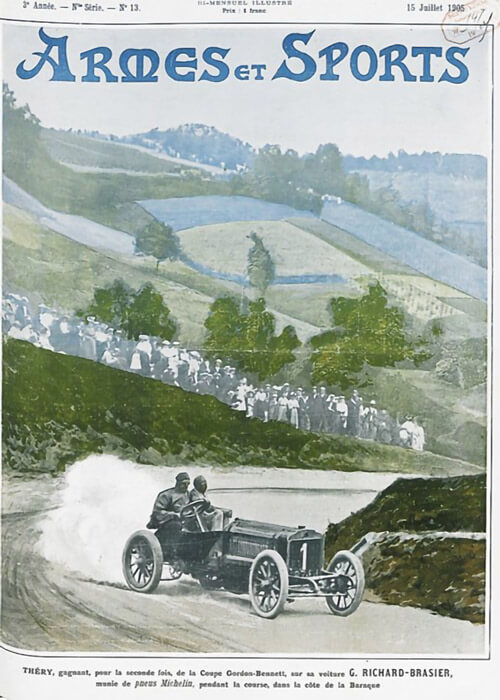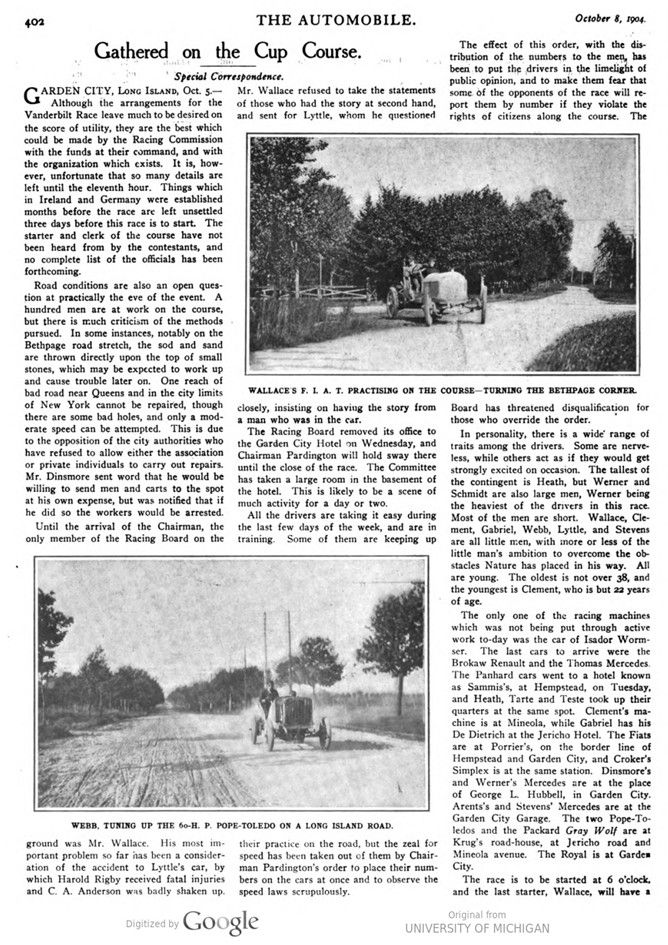
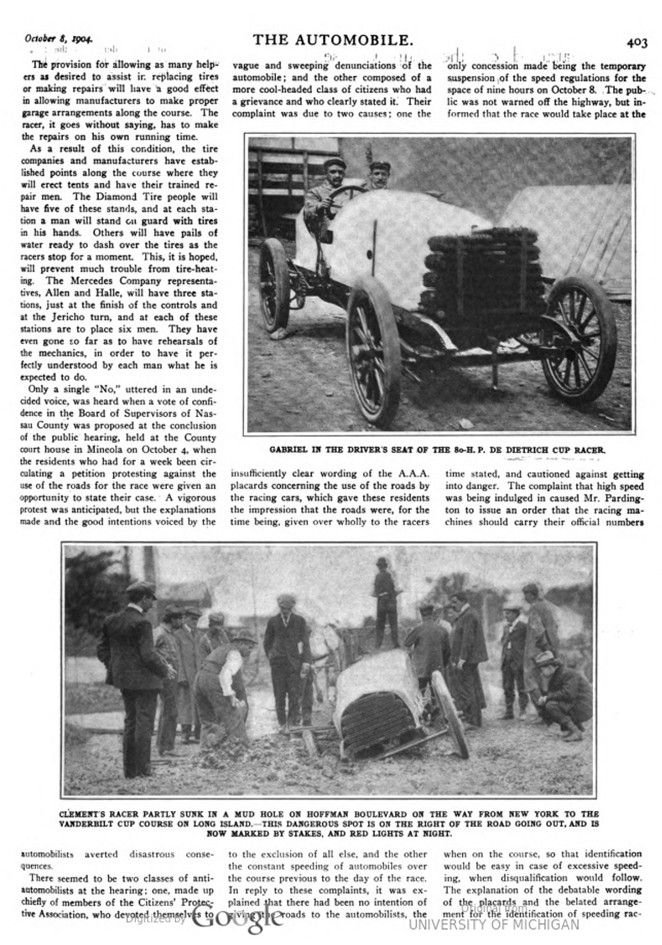
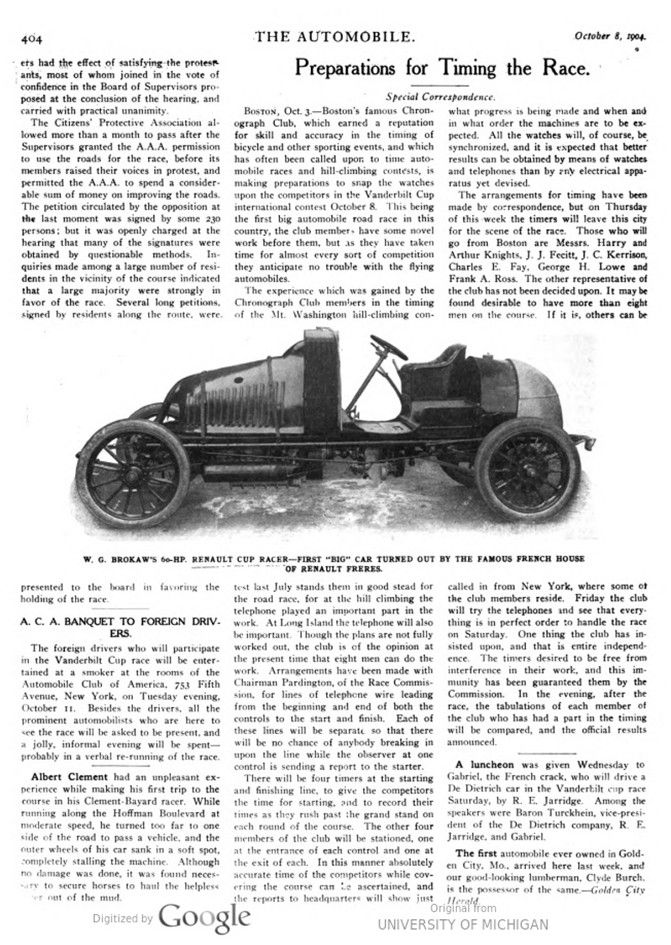
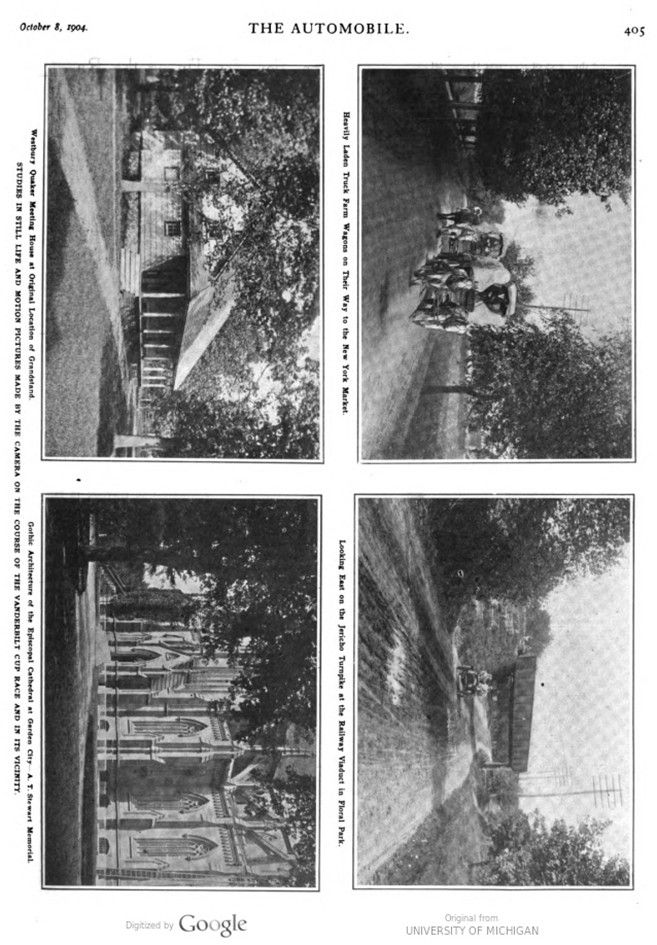
Text and pictures with courtesy of hathitrust hathtrust.org, compiled by motorracinghistory
THE AUTOMOBILE – SATURDAY, OCTOBER 8, 1904 – Pages 402 – 405
Gathered on the Cup Course.
Special Correspondence.
GARDEN CITY, LONG ISLAND, Oct. 5. – Although the arrangements for the Vanderbilt Race leave much to be desired on the score of utility, they are the best which could be made by the Racing Commission with the funds at their command, and with the organization which exists. It is, however, unfortunate that so many details are left until the eleventh hour. Things which in Ireland and Germany were established months before the race are left unsettled three days before this race is to start. The starter and clerk of the course have not been heard from by the contestants, and no complete list of the officials has been forthcoming.
Road conditions are also an open question at practically the eve of the event. A hundred men are at work on the course, but there is much criticism of the methods pursued. In some instances, notably on the Bethpage Road stretch, the sod and sand are thrown directly upon the top of small stones, which may be expected to work up and cause trouble later on. One reach of bad road near Queens and in the city limits of New York cannot be repaired, though there are some bad holes, and only a moderate speed can be attempted. This is due to the opposition of the city authorities who have refused to allow either the association or private individuals to carry out repairs. Mr. Dinsmore sent word that he would be willing to send men and carts to the spot at his own expense, but was notified that if he did so the workers would be arrested.
Until the arrival of the Chairman, the only member of the Racing Board on the ground was Mr. Wallace. His most important problem so far has been a consideration of the accident to Lyttle’s car, by which Harold Rigby received fatal injuries and C. A. Anderson was badly shaken up.
Mr. Wallace refused to take the statements of those who had the story at second hand, and sent for Lyttle, whom he questioned closely, insisting on having the story from a man who was in the car.
The Racing Board removed its office to the Garden City Hotel on Wednesday, and Chairman Pardington will hold sway there until the close of the race. The Committee has taken a large room in the basement of the hotel. This is likely to be a scene of much activity for a day or two.
All the drivers are taking it easy during the last few days of the week, and are in training. Some of them are keeping up their practice on the road, but the zeal for speed has been taken out of them by Chairman Pardington’s order to place their numbers on the cars at once and to observe the speed laws scrupulously.
The effect of this order, with the distribution of the numbers to the men, has been to put the drivers in the limelight of public opinion, and to make them fear that some of the opponents of the race will report them by number if they violate the rights of citizens along the course. The Board has threatened disqualification for those who override the order.
In personality, there is a wide range of traits among the drivers. Some are nerveless, while others act as if they would get strongly excited on occasion. The tallest of the contingent is Heath, but Werner and Schmidt are also large men, Werner being the heaviest of the drivers in this race. Most of the men are short. Wallace, Clement, Gabriel, Webb, Lyttle, and Stevens are all little men, with more or less of the little man’s ambition to overcome the obstacles Nature has placed in his way. All are young. The oldest is not over 38, and the youngest is Clement, who is but 22 years of age.
The only one of the racing machines which was not being put through active work to-day was the car of Isador Wormser. The last cars to arrive were the Brokaw Renault and the Thomas Mercedes. The Panhard cars went to a hotel known as Sammis’s, at Hempstead, on Tuesday, and Heath, Tarte and Teste took up their quarters at the same spot. Clement’s machine is at Mineola, while Gabriel has his De Dietrich at the Jericho Hotel. The Fiats are at Porrier’s, on the border line of Hempstead and Garden City, and Croker’s Simplex is at the same station. Dinsmore’s and Werner’s Mercedes are at the place of George L. Hubbell, in Garden City. Arents’s and Stevens‘ Mercedes are at the Garden City Garage. The two Pope-Toledo’s and the Packard Gray Wolf are at Krug’s road-house, at Jericho road and Mineola avenue. The Royal is at Garden City.
The race is to be started at 6 o’clock, and the last starter, Wallace, will have a ….
*** (sorry; couldn’t find the rest of this sentence; grocerjack) ***
The provision for allowing as many helpers as desired to assist in replacing tires or making repairs will have a good effect in allowing manufacturers to make proper garage arrangements along the course. The racer, it goes without saying, has to make the repairs on his own running time.
As a result of this condition, the tire companies and manufacturers have established points along the course where they will erect tents and have their trained repair men. The Diamond Tire people will have five of these stands, and at each station a man will stand on guard with tires in his hands. Others will have pails of water ready to dash over the tires as the racers stop for a moment. This, it is hoped, will prevent much trouble from tire-heating. The Mercedes Company representatives, Allen and Halle, will have three stations, just at the finish of the controls and at the Jericho turn, and at each of these stations are to place six men. They have even gone so far as to have rehearsals of the mechanics, in order to have it perfectly understood by each man what he is expected to do.
Only a single „No,“ uttered in an undecided voice, was heard when a vote of confidence in the Board of Supervisors of Nassau County was proposed at the conclusion of the public hearing, held at the County court house in Mineola on October 4, when the residents who had for a week been circulating a petition protesting against the use of the roads for the race were given an opportunity to state their case. A vigorous protest was anticipated, but the explanations made and the good intentions voiced by the automobilists averted disastrous consequences.
There seemed to be two classes of anti-automobilists at the hearing; one, made up chiefly of members of the Citizens‘ Protective Association, who devoted themselves to vague and sweeping denunciations of the automobile; and the other composed of a more cool-headed class of citizens who had a grievance and who clearly stated it. Their complaint was due to two causes; one the insufficiently clear wording of the A.A.A. placards concerning the use of the roads by the racing cars, which gave these residents the impression that the roads were, for the time being, given over wholly to the racers to the exclusion of all else, and the other the constant speeding of automobiles over the course previous to the day of the race. In reply to these complaints, it was explained that there had been no intention of giving the roads to the automobilists, the only concession made being the temporary suspension of the speed regulations for the space of nine hours on October 8. The public was not warned off the highway, but informed that the race would take place at the time stated, and cautioned against getting into danger. The complaint that high speed was being indulged in caused Mr. Pardington to issue an order that the racing machines should carry their official numbers when on the course, so that identification would be easy in case of excessive speeding, when disqualification would follow. The explanation of the debatable wording of the placards and the belated arrangement for the identification of speeding racers had the effect of satisfying the protest ants, most of whom joined in the vote of confidence in the Board of Supervisors proposed at the conclusion of the hearing, and carried with practical unanimity.
The Citizens‘ Protective Association allowed more than a month to pass after the Supervisors granted the A.A.A. permission to use the roads for the race, before its members raised their voices in protest, and permitted the A.A.A. to spend a considerable sum of money on improving the roads. The petition circulated by the opposition at the last moment was signed by some 230 persons; but it was openly charged at the hearing that many of the signatures were obtained by questionable methods. Inquiries made among a large number of residents in the vicinity of the course indicated that a large majority were strongly in favor of the race. Several long petitions, signed by residents along the route, were presented to the board in favoring the holding of the race.
Preparations for Timing the Race.
Special Correspondence.
BOSTON, Oct. 3. – Boston’s famous Chronograph Club, which earned a reputation for skill and accuracy in the timing of bicycle and other sporting events, and which has often been called upon to time automobile races and hill-climbing contests, is making preparations to snap the watches upon the competitors in the Vanderbilt Cup international contest October 8. This being the first big automobile road race in this country, the club members have some novel work before them, but as they have taken time for almost every sort of competition they anticipate no trouble with the flying automobiles.
The experience which was gained by the Chronograph Club members in the timing of the Mt. Washington hill-climbing contest last July stands them in good stead for the road race, for at the hill climbing the telephone played an important part in the work. At Long Island the telephone will also be important. Though the plans are not fully worked out, the club is of the opinion at the present time that eight men can do the work. Arrangements have been made with Chairman Pardington, of the Race Commission, for lines of telephone wire leading from the beginning and end of both the controls to the start and finish. Each of these lines will be separate so that there will be no chance of anybody breaking in upon the line while the observer at one control is sending a report to the starter.
There will be four timers at the starting and finishing line, to give the competitors the time for starting, and to record their times as they rush past the grand stand on each round of the course. The other four members of the club will be stationed, one at the entrance of each control and one at the exit of each. In this manner absolutely accurate time of the competitors while covering the course can be ascertained, and the reports to headquarters will show just what progress is being made and when and in what order the machines are to be expected. All the watches will, of course, be synchronized, and it is expected that better results can be obtained by means of watches and telephones than by any electrical apparatus yet devised.
The arrangements for timing have been made by correspondence, but on Thursday of this week the timers will leave this city for the scene of the race. Those who will go from Boston are Messrs. Harry and Arthur Knights, J. J. Fecitt, J. C. Kerrison, Charles E. Fay, George H. Lowe and Frank A. Ross. The other representative of the club has not been decided upon. It may be found desirable to have more than eight men on the course. If it is, others can be called in from New York, where some of the club members reside. Friday the club will try the telephones and see that everything is in perfect order to handle the race on Saturday. One thing the club has insisted upon, and that is entire independence. The timers desired to be free from interference in their work, and this immunity has been guaranteed them by the Commission. In the evening, after the race, the tabulations of each member of the club who has had a part in the timing will be compared, and the official results announced.
A. C. A. BANQUET TO FOREIGN DRIVERS.
The foreign drivers who will participate in the Vanderbilt Cup race will be entertained at a smoker at the rooms of the Automobile Club of America, 753 Fifth Avenue, New York, on Tuesday evening, October II. Besides the drivers, all the prominent automobilists who are here to see the race will be asked to be present, and a jolly, informal evening will be spent – probably in a verbal re-running of the race.
Albert Clement had an unpleasant experience while making his first trip to the course in his Clement-Bayard racer. While running along the Hoffman Boulevard at moderate speed, he turned too far to one side of the road to pass a vehicle, and the outer wheels of his car sank in a soft spot, completely stalling the machine. Although no damage was done, it was found necessary to secure horses to haul the helpless er out of the mud.
A luncheon was given Wednesday to Gabriel, the French crack, who will drive a De Dietrich car in the Vanderbilt cup race Saturday, by R. E. Jarridge. Among the speakers were Baron Turckhein, vice-president of the De Dietrich company, R. E. Jarridge, and Gabriel.
The first automobile ever owned in Golden City, Mo., arrived here last week, and our good-looking lumberman, Clyde Burch, is the possessor of the same.- Golden City Herald.
Photo captions.
Page 402.
WALLACE’S F. I. A. T. PRACTISING ON THE COURSE-TURNING THE BETHPAGE CORNER.
WEBB, TUNING UP THE 60-H. P. POPE-TOLEDO ON A LONG ISLAND ROAD.
Page 403.
GABRIEL IN THE DRIVER’S SEAT OF THE 80-H. P. DE DIETRICH CUP RACER.
CLEMENT’S RACER PARTLY SUNK IN A MUD HOLE ON HOFFMAN BOULEVARD ON THE WAY FROM NEW YORK TO THE VANDERBILT CUP COURSE ON LONG ISLAND. THIS DANGEROUS SPOT IS ON THE RIGHT OF THE ROAD GOING OUT, AND IS NOW MARKED BY STAKES, AND RED LIGHTS AT NIGHT.
Pae 404.
W. G. BROKAW’S 60-HP. RENAULT CUP RACER – FIRST „BIG“ CAR TURNED OUT BY THE FAMOUS FRENCH HOUSE OF RENAULT FRERES.
Page 405.
Heavily Laden Truck Farm Wagons on Their Way to the New York Market.
Looking East on the Jericho Turnpike at the Railway Viaduct in Floral Park.
Westbury Quaker Meeting House at Original Location of Grandstand.
Gothic Architecture of the Episcopal Cathedral at Garden City A. T. Stewart Memorial.
STUDIES IN STILL LIFE AND MOTION PICTURES MADE BY THE CAMERA ON THE COURSE OF THE VANDERBILT CUP RACE AND IN ITS VICINITY.
